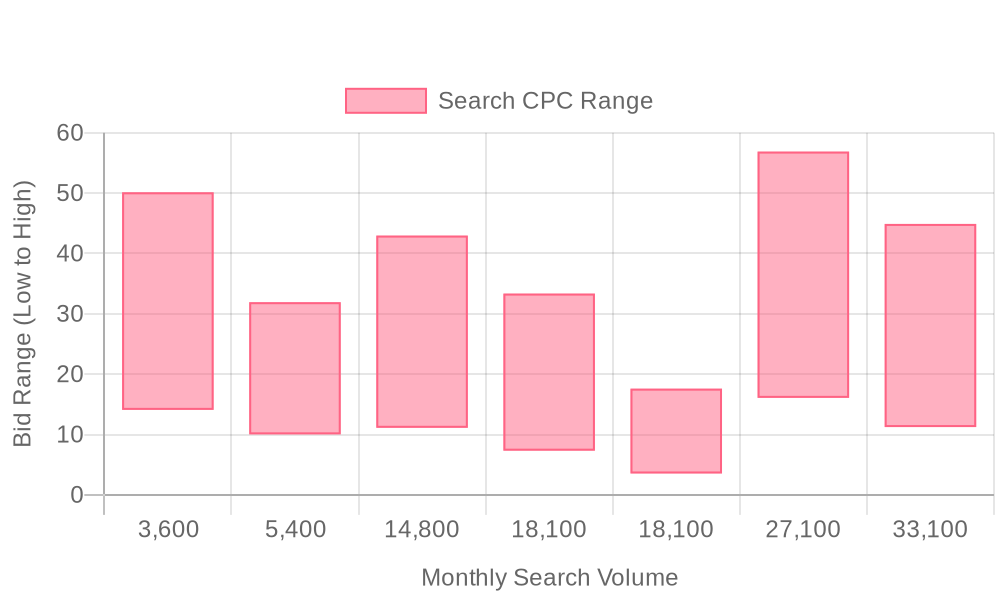
Supercharge your lead generation with a FREE Google Ads audit - no strings attached! See how you can generate more and higher quality leads
Get My Free Google Ads AuditFree consultation

No commitment
Supercharge your lead generation with a FREE Google Ads audit - no strings attached! See how you can generate more and higher quality leads
Get My Free Google Ads AuditFree consultation

No commitment
In today's competitive landscape, business schools face significant challenges in attracting the right pool of prospective students. Traditional recruiting methods often fall short, particularly when high-value prospects go unnoticed, leading to lost opportunities. As prospective students often cross different digital touchpoints, there's a necessity for advanced targeting solutions. Google Ads offers a potent platform by placing your school directly in front of potential students precisely when they are searching for educational opportunities. Leveraging Google Ads can seamlessly integrate into your broader marketing ecosystem by pinpointing the precise moment prospective students express interest, facilitating targeted and efficient communication. Additionally, tools that provide account-level granularity and identify anonymous traffic can significantly enhance targeting precision, eliminating blind spots. Google Ads’ precision targeting capabilities are especially effective at reaching decision-makers at critical moments, ultimately enhancing the impact of your marketing efforts.

Business schools face a unique challenge: attracting high-intent prospects who are actively seeking advanced educational opportunities, but may be overwhelmed by competing programs and generic messaging. A data-driven Google Ads strategy allows your institution to precisely reach and engage ideal candidates at every stage of their decision-making journey, ensuring that your marketing dollars are allocated to prospects most likely to convert.
Modern revenue teams require actionable insights that go beyond traditional metrics. With unified go-to-market data, marketers can identify not only which campaigns generate clicks, but which individual prospects and companies are engaging with your ads, demo forms, and landing pages. For deeper insights on identifying visitors, Sona Identification reveals unknown companies and people engaging with your assets, transforming online advertising from guesswork into a measurable, scalable growth engine.
Creating an effective Google Ads campaign for business schools starts with a strategic, step-by-step framework that integrates seamlessly with your broader multichannel marketing efforts. Marketers must focus on identifying unique keywords and audience targeting strategies tailored for aspiring business students, since these prospects often display distinct online behaviors compared to undergraduate or general education seekers. Explore actionable Google Ads tips for schools to refine your targeting, and leverage intent-signals and real-time behavioral data to shift budgets toward high-converting accounts as soon as they show interest.
Aligning your landing pages and ad creatives to maximize conversions is critical, especially for business schools where demo interest and campus visit bookings frequently stall before completion. Personalization plays a major role: dynamic audience building ensures that messaging and offers update automatically as leads progress through the funnel, increasing relevance and reducing friction for each prospect. When a candidate abandons a demo form or leaves a critical page, tailored Google Ads can be served to re-engage them with the program details, resources, or events most likely to spark action.
Continuous performance optimization is essential for business schools competing for top-tier applicants. Advanced conversion tracking and attribution allow you to measure the true ROI of each campaign—including both online and offline events, such as applications submitted after an admissions phone call or in-person info session. Integrating your CRM with Google Ads ensures that enriched leads and audience segments are always in sync, so your retargeting and lookalike modeling efforts remain current and effective across channels.
A holistic approach to education marketing means that insights from Google Ads campaigns for colleges can inform strategies on other platforms, driving efficiencies and uncovering new opportunities for student recruitment ads. By building a feedback loop between channels and unifying first-party prospect engagement data, your team can make smarter decisions, iterate faster, and consistently improve outcomes for both marketing and admissions stakeholders. If you’re ready to elevate your campaigns, get started for free with Sona today and accelerate your student recruitment.

Business schools operate in a fiercely competitive environment where identifying and reaching motivated prospects is vital for sustained enrollment growth. Google Ads empowers marketing teams to capture high-intent search queries from potential students who are actively researching MBA programs, executive education, or specialized business degrees. To further understand how educational institutions can leverage Google Ads to attract students, see this overview for education marketing. By surfacing ads precisely when candidates are exploring their options, schools can establish immediate relevance and drive engagement at the critical moment of consideration.
Targeted outreach through Google Ads allows business schools to address the challenge of anonymous web traffic. With advanced visitor identification and real-time behavioral insights, marketers can pinpoint both the individuals and organizations showing genuine interest. This shifts campaign focus and budget to high-converting prospects, accelerating the lead pipeline and ensuring more personalized follow-up across the entire enrollment funnel.
Immediate impact is a defining advantage of Google Ads for business schools. Unlike organic channels that require months to gain traction, paid campaigns generate visibility and qualified inquiries within hours of launch. This rapid feedback loop shortens the time from initial impression to meaningful connection, driving measurable results during peak recruitment seasons or when launching new program offerings. To dive deeper into optimizing paid campaigns for education, explore our blog on marketing analytics.
Enhanced visibility is critical for institutions looking to expand into new markets or reach underrepresented student profiles. Google Ads extends brand presence into highly specific regions, industries, or cohorts, outperforming traditional outreach methods that often fall short in fragmented media landscapes. This localized targeting ensures every dollar spent reaches the right audience, maximizing return on investment and supporting long-term enrollment diversity goals. For teams seeking dynamic audience segmentation, advanced tools can support these targeting strategies.
Informed decision-making is central to any business school’s growth strategy. Google Ads provides granular tracking from the first click through to application and enrollment, allowing teams to refine messaging, creative, and spend allocation based on real performance data. By integrating enriched lead insights and syncing audiences directly with CRM and marketing automation platforms, campaign results become actionable intelligence, guiding smarter decisions and continuous improvement across digital marketing for schools. To see how you can streamline your digital campaigns, get started for free with Sona and unlock data-driven marketing solutions.

Growth-focused business schools consistently outperform by identifying and acting on opportunities beyond their primary marketing channels. Expanding into underutilized digital spaces ensures a steady flow of high-quality student leads while maintaining cost efficiency. For a step-by-step look at how educational institutions can use Google Ads to attract students and boost enrollment, see this guide to Google Ads for education. If you want to see how advanced marketing analytics can fuel optimization, explore our blog on marketing analytics.
This holistic approach, grounded in precise targeting and enriched by real-time data, enables business schools to find and capitalize on growth opportunities that traditional digital marketing for schools channels often miss. If you’re ready to identify and activate new growth opportunities, get started for free with Sona.

Business schools that leverage advanced audience segmentation consistently outperform generic, one-size-fits-all digital marketing approaches. Precise segmentation ensures campaigns are tailored to the unique motivations and backgrounds of each prospective student cohort, resulting in higher engagement rates and improved return on ad spend. For a deeper look at segmentation strategies and analytics, visit the marketing analytics blog.

| Industry | Keyword | Monthly Search Volume | Competition Level | Low Bid | High Bid |
| Business Schools | affordable online mba programs | 3600 | MEDIUM | 14.09 | 50.14 |
| Business Schools | executive mba programs | 5400 | MEDIUM | 10.03 | 31.93 |
| Business Schools | mba programs | 14800 | MEDIUM | 11.12 | 42.96 |
| Business Schools | business schools | 18100 | MEDIUM | 7.33 | 33.35 |
| Business Schools | business classes | 18100 | LOW | 3.55 | 17.6 |
| Business Schools | online mba programs | 27100 | MEDIUM | 16.08 | 56.88 |
| Business Schools | best online mba programs | 33100 | MEDIUM | 11.24 | 44.9 |
Effective Google Ads strategies for business schools begin with meticulous keyword planning, as the right terms ensure relevant visibility and efficient budget allocation. Strategic keyword targeting allows institutions to intercept prospective students researching MBA programs, executive education, or specialized certificates, focusing spend on high-value in-market audiences. By integrating account-based insights, marketers can identify which business professionals or recent graduates are actively comparing schools, then dynamically adjust keyword focus as intent signals shift.
Precision targeting depends on leveraging granular data to capture students at the moment of research. Rather than relying on broad terms like "business degree," advanced campaigns deploy long-tail and program-specific keywords such as "MBA in finance New York" or "best executive MBA Europe." These nuanced terms not only reduce wasted spend but attract candidates whose search behavior indicates a strong fit and intent to convert.
Measurable ROI becomes possible when keyword performance is directly linked to enrollment outcomes. Enhanced data enrichment and attribution capabilities enable marketing teams to connect clicks and impressions with actual student applications, interviews, and accepted offers. For actionable insights and optimization tips, explore this Google Ads guide for education. By continuously syncing this conversion data back into campaign management, teams can double down on high-performing terms while pausing underperformers, ensuring a cycle of ongoing improvement.
Channel synergy amplifies results by weaving Google Ads into a broader digital marketing mix. Retargeting strategies, powered by unified visitor identification, allow business schools to re-engage prospective students who have interacted with key website pages or started an application but have not yet completed it. Responsive budget shifting, informed by real-time engagement and intent signals, ensures maximum impact even as applicant interest ebbs and flows throughout the admissions cycle. For marketing teams looking to enhance their targeting and measurement, you can get started for free with Sona and optimize your digital campaigns with advanced analytics.
Effective Google Ads for business schools begins with a rigorous approach to keyword selection and structure. Classifying keywords by program type—such as full-time MBA, part-time MBA, executive education, or specialized master’s—ensures each campaign segment aligns with the nuanced intent of distinct applicant profiles. Geo-targeting fine-tunes reach, enabling teams to prioritize local, regional, or international prospects based on institutional priorities or emerging markets. For actionable strategies on education-specific keyword targeting, explore this Google Ads keyword guide for education. Leveraging long-tail keywords is essential; phrases like “STEM MBA in New York” or “part-time business analytics program for working professionals” naturally filter for high-value leads who are closer to conversion and more likely to engage.
When data unification platforms are integrated, teams gain a clearer picture of which keyword themes generate the most qualified pipeline. Instead of relying solely on front-end click or impression metrics, marketers can identify which queries correlate with application starts, interview bookings, or admits. Dynamic keyword lists adapt as market demand shifts and new high-intent segments are detected through real-time behavioral signals across digital channels, maximizing efficiency and budget allocation.
Developing ad copy for business school campaigns requires more than just keyword insertion. Headlines must immediately highlight unique program benefits—such as accelerated graduation timelines, dual-degree options, or exclusive industry partnerships—that distinguish your offering in a competitive field. Including trust markers, like global rankings or alumni success stories, builds credibility and reassures prospects evaluating multiple institutions. For a comprehensive breakdown of ad copy best practices and examples, visit this step-by-step Google Ads setup guide for education. Incentives, such as application fee waivers or early-bird scholarship alerts, deliver a targeted nudge for users retargeted with custom messaging after visiting your site or engaging with content.
With advanced visitor identification, marketing teams can move beyond generic messaging to personalize ads based on known behaviors or company affiliations. For instance, if a prospective student has previously engaged with leadership development seminar content, retargeting ads can reference those interests, making outreach more relevant and increasing the likelihood of inquiry. This level of granularity ensures that every ad dollar works harder, aligning creative assets with the prospect’s place in the decision funnel.
A seamless experience from ad click to landing page is critical for converting prospective students. Each landing page should provide a direct 1:1 alignment with the ad’s promise, featuring detailed program information, clear calls to action, and content tailored to the prospect’s segment. Highlighting academic accolades, graduate outcomes, and compelling student testimonials strengthens trust and addresses common barriers to engagement. When traditional forms go unsubmitted, intelligent follow-up mechanisms—such as chatbots or progressive forms—capture additional data points and re-engage high-value visitors. For more inspiration on optimizing education landing pages for conversions, see this guide to Google Ads for schools.
By tying real-time site behavior to CRM records, marketing teams can attribute form fills, event registrations, and even offline interactions back to the original campaign and keyword. This unified data view enables precise optimization of landing page elements, from headline variations to the placement of trust signals, ensuring every touchpoint is engineered for maximum conversion efficiency.
Achieving sustained enrollment growth requires ongoing measurement and improvement across every stage of the funnel. Tracking both micro-conversions (like brochure downloads or webinar signups) and macro-conversions (such as applications or deposits) provides a comprehensive understanding of which tactics are driving measurable impact. For a broader look at optimization strategies in education PPC, review this comprehensive education PPC guide. Integrating CRM and ad platform data allows teams to segment out unqualified leads, focus spend on the highest-fit prospects, and reduce wasted effort.
Smart bidding strategies, such as Target CPA or custom conversion value models, adapt in real time as new performance insights emerge. When audience and lead data is dynamically synced between Google Ads and core systems, automated workflows ensure that outreach, retargeting, and budget allocation are always aligned with the latest intelligence. This data-driven approach empowers business schools to refine audience definitions, bid strategies, and creative content continuously, maximizing ROI and driving real enrollment results. Ready to optimize your enrollment funnel? Get started for free with Sona.

A strong digital presence is essential for business schools seeking to engage prospective students and expand institutional influence. Modern education marketing leverages targeted online advertising and data-driven outreach to connect with high-intent candidates, optimize recruitment spend, and amplify program visibility. For a detailed look at how schools can use Google Ads to boost enrollment, explore this comprehensive guide to Google Ads for education. To further refine your strategy, visit our marketing analytics blog for actionable insights.
A unified, data-driven approach to digital marketing for business schools delivers measurable improvements in student recruitment, brand strength, and program growth. By combining retargeting, segmented audience enrichment, strategic partnerships, and localization, your institution can build a digital presence that stands out in a competitive global market. To see how you can implement these strategies seamlessly, get started for free with Sona and unlock your school's digital marketing potential.
Google Ads offer a transformative opportunity for business schools to elevate their marketing strategies and attract the right prospective students. By harnessing the power of targeted advertising, educational institutions can navigate the competitive landscape of higher education with precision and impact.
Throughout this discussion, we delved into the challenges of reaching potential students and the strategic use of Google Ads to overcome them. From crafting compelling ad copy to leveraging data analytics for enhanced targeting, each element plays a crucial role in optimizing your campaigns and maximizing enrollment potential.
Imagine the growth your institution can achieve by implementing these techniques. With the right approach, your business school can connect with engaged, motivated students who are eager to embark on their educational journey with you. It's time to embrace these strategies and witness the transformative impact they can have on your enrollment numbers.
If you're ready to take your marketing efforts to the next level, start for free
Google Ads offers business schools the ability to target high-intent prospects precisely when they are searching for educational opportunities, enhancing visibility and engagement, and allowing for immediate impact and measurable results.
Business schools can create effective Google Ads campaigns by using a strategic framework that includes precise keyword targeting, personalized ad messaging, optimized landing pages, and continuous performance optimization.
Business schools should target long-tail and program-specific keywords like 'MBA in finance New York' or 'best executive MBA Europe' to attract high-value, high-intent prospects.
The budget for Google Ads should be flexible and data-driven, allowing for shifts towards high-converting accounts as real-time behavioral and intent signals are monitored.
Business schools can measure the success of Google Ads by integrating conversion tracking and CRM systems to attribute online and offline actions directly to campaigns, ensuring marketing efforts are aligned with enrollment outcomes.
Join results-focused teams combining Sona Platform automation with advanced Google Ads strategies to scale lead generation

Connect your existing CRM

Free Account Enrichment

No setup fees
No commitment required

Free consultation

Get a custom Google Ads roadmap for your business
Join results-focused teams using Sona Platform automation to activate unified sales and marketing data, maximize ROI on marketing investments, and drive measurable growth

Connect your existing CRM

Free Account Enrichment

No setup fees
No commitment required

Free consultation

Get a custom Google Ads roadmap for your business
Over 500+ auto detailing businesses trust our platform to grow their revenue
Join results-focused teams using Sona Platform automation to activate unified sales and marketing data, maximize ROI on marketing investments, and drive measurable growth

Connect your existing CRM

Free Account Enrichment

No setup fees
No commitment required

Free consultation

Get a custom Google Ads roadmap for your business
Over 500+ auto detailing businesses trust our platform to grow their revenue
Join results-focused teams using Sona Platform automation to activate unified sales and marketing data, maximize ROI on marketing investments, and drive measurable growth

Connect your existing CRM

Free Account Enrichment

No setup fees
No commitment required

Free consultation

Get a custom Google Ads roadmap for your business
Over 500+ auto detailing businesses trust our platform to grow their revenue
Join results-focused teams using Sona Platform automation to activate unified sales and marketing data, maximize ROI on marketing investments, and drive measurable growth

Connect your existing CRM

Free Account Enrichment

No setup fees
No commitment required

Free consultation

Get a custom Google Ads roadmap for your business
Over 500+ auto detailing businesses trust our platform to grow their revenue
Our team of experts can implement your Google Ads campaigns, then show you how Sona helps you manage exceptional campaign performance and sales.
Schedule your FREE 15-minute strategy sessionOur team of experts can help improve your demand generation strategy, and can show you how advanced attribution and data activation can help you realize more opportunities and improve sales performance.
Schedule your FREE 30-minute strategy sessionOur team of experts can help improve your demand generation strategy, and can show you how advanced attribution and data activation can help you realize more opportunities and improve sales performance.
Schedule your FREE 30-minute strategy sessionOur team of experts can help improve your demand generation strategy, and can show you how advanced attribution and data activation can help you realize more opportunities and improve sales performance.
Schedule your FREE 30-minute strategy sessionOur team of experts can help improve your demand generation strategy, and can show you how advanced attribution and data activation can help you realize more opportunities and improve sales performance.
Schedule your FREE 30-minute strategy session





Launch campaigns that generate qualified leads in 30 days or less.
